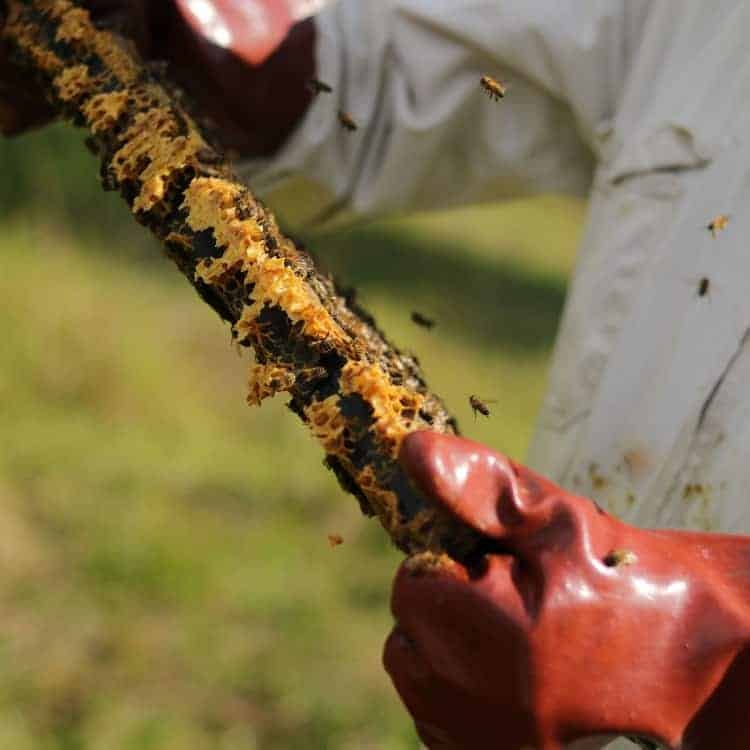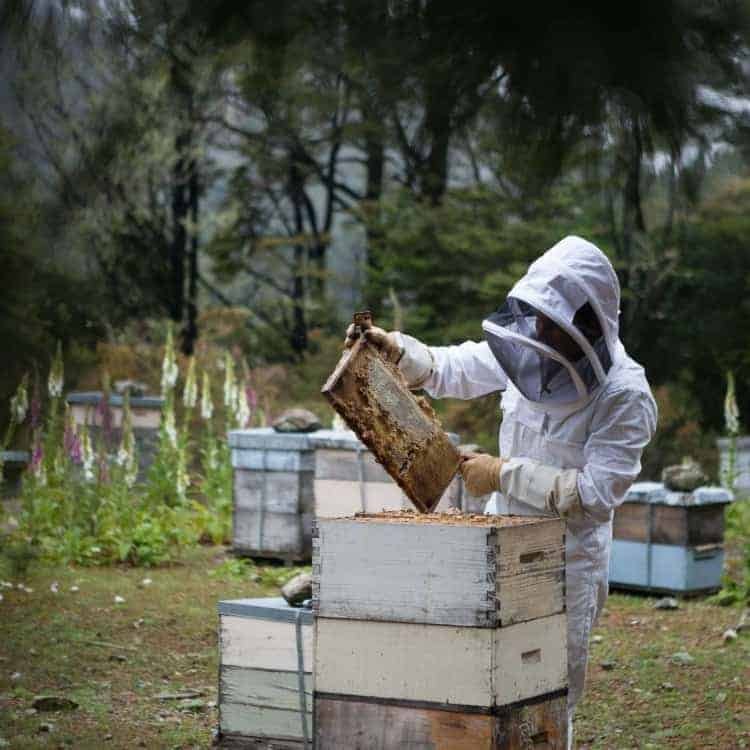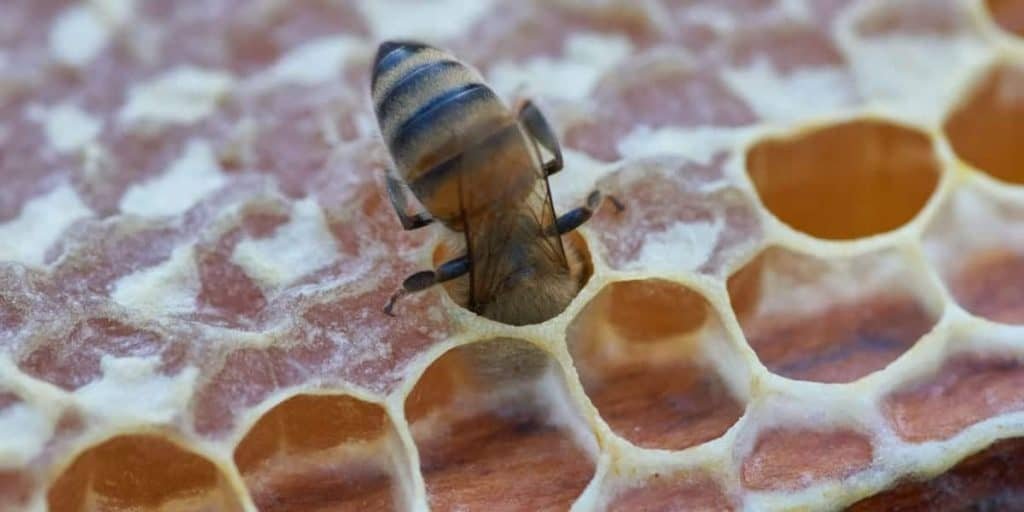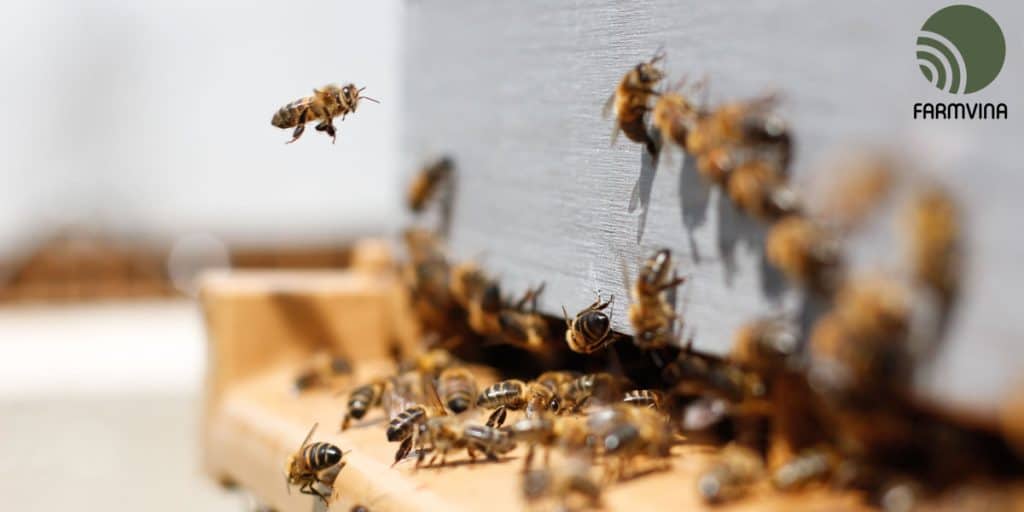Bee Diseases And Dangers
Like any animal or insect, honeybees can become ill through parasites and diseases. Even under the best circumstances, your hive is always at risk of diseases and parasites being introduced. There are a number of bee diseases and parasites that pose danger to honeybee colonies that anyone considering beekeeping should be aware of.
Robber Bees
We have discussed things that can affect the health of your hive: bee diseases, parasites, loss of the queen, starvation, and so on. However, one obstacle not mentioned is your hive being burglarized by the last people that you would expect: other honeybees. The aptly named robber bees usually come about during hard times food-wise. Bees from one hive will come and steal the stores of another hive.
A robber bee finds hives by scent and goes back to its colony. Then they get together and go back to steal the stores of the other colony. After the scout robber finds a target hive, it will look for an unprotected entrance and weak spots among the guards. Once it has found that, it will return to its home and send others to come and steal the honey. Sometimes, the worker bees will be able to fight off the robber bees.
Other times, the robber bees can decimate a hive, as they will continue to return until the honey is gone. In fact, should the robber bees attack in groups, especially when a hive is weak, the invaders can overwhelm the entire colony, resulting in many deaths and, in extreme cases, even the killing of the queen. Robber bees will leave the victim hive or hives to starve to death.
Compounding the problem is the threat of foreign infection. Robber bees can also spread bee disease, and not only to the victim hives. If one of your hives turns robber (due to insufficient food stores) and goes to another hive in an apiary that has a disease problem, it will bring that disease back to the hive.
Likewise, if your healthy hive is invaded by diseased robber bees from another apiary, they can spread the disease to your hive. At the same time, if your hive is diseased, the robber bee that invades it will take the disease back to their apiary and hive.
There are ways to protect your hives from robbers and prevent your own bees from becoming robbers. Keep the entrance to the hive small. Make sure that your hive/colony is strong and healthy. The stronger and healthier it is, the better your bees can defend themselves.
Finally, to prevent your own bees from becoming robbers, make sure that your colonies always have enough food. In lean foraging times, this may mean providing supplements and substitutes for your bees to eat. It may also mean not taking honey for yourself so your bees have enough to sustain themselves throughout the winter. Whether it is your bees turning robber or you are invaded by bees from another apiary, robber bees are something that you do not want or need around your hives or colonies.
Parasites
Varroa Mites
Varroa mites feed on the bodily fluids of the honeybees in every stage of life: larval, pupal, and adult. Seen on the bee as a small red or brown spot on the thorax (and visible by the eye), the varroa mite carries a virus that causes noticeably deformed wings on the honeybee. While the varroa mite is admittedly more of a problem during the winter preparation time or in times of poor foraging (both of which are periods of low colony population), it can be a serious threat to your hives.
The varroa mite has almost eliminated whole colonies in some areas, as well as causing problems in apiaries, although, in some of these places, the bees are recovering and making a comeback.
Fortunately, there are treatments available for honeybees against the varroa mite. Some treatments are chemical based, while others are mechanical or manual treatments. The substances used in chemical treatments include formic acid, oxalic acid, fluvalinate, thymol, and coumaphos.

Although it is said that these chemicals should not cause any problems with the honeybees, they are not to be used during the time that honey is being produced when intended for marketing or consumption. Mechanical or manual treatments of the varroa mite include dronebrood sacrifice, which is the elimination of the brood.
Powdered-sugar dusting of the bees is also said to work, as it encourages the bees to clean themselves, leading them to dislodge some of the mites. Screen bottom boards on the hive are also recommended when using this technique, as it allows dislodged mites to fall through the cracks instead of into the hive.
These are not the only treatments available for a hive dealing with varroa mites, but they are the most commonly used. However, there are a variety of resources available to the novice beekeeper for treating this and other infestations. You should always seek the treatment method that is best for you, your bees, and your hive.
Acarine Mites
Believed to have come to the United States through Mexico, acarine mites (also known as tracheal mites) infest the airways of the honeybee. The mature female mite will then make her way out of the bee’s airway and out onto the bee’s hair.
At that point, it waits to transfer to young bees, where it will again infest the airway and begin to lay eggs. Acarine mites almost wiped out the British Isles’ bee population in the early twentieth century. As a result, the Buckfast bee was developed at Buckfast Abbey. Treatment for the acarine mites can be pretty simple through the use of grease patties. Grease patties are one part vegetable shortening combined with three to four parts of powdered sugar.
The patties are then placed on top of the bars of the hive’s outer cover. The bees will then nibble at the little cakes, and, when they do, the shortening makes it almost impossible for the mites to infest the young bees. This, in turn, causes some of the mites to die before they are able to locate a young bee and reproduce, as a young bee is necessary for the mites’ reproduction process.
Wax Moths
The wax moth feeds on the wax of the honeycomb, used brood cells, and cell cleanings, all of which contain essential proteins for the development of the wax moth larvae. This destruction of the honeycomb may cause stored honey to spoil and/or become contaminated. It can also kill the honeybee larvae.
The wax moth will spread rapidly at high temperatures, usually at 90°F and above. However, in regions where this type of temperature occurs only occasionally, the hive will experience few problems with the wax moth (unless it is already a weak bee colony).
There are a few treatments for hives troubled by the wax moth. Two of the most common methods are strong hives taking care of the problem itself, with the honeybees killing and cleaning out the wax moth larvae and the webs that the larvae create to move around on and then leave behind. The second treatment takes advantage of the fact that the wax moth can be killed by freezing.
So, in colder climates, hive storage in unheated sheds, barns, or outdoors could also work as a treatment. However, with all that said, the stronger your colony is, the more that it will be able to protect itself from the wax moth.
Small Hive Beetles
The small hive beetle is a small, dark beetle that lives inside the hive; it is a scavenger of weak hives/colonies. The small hive beetle will cause considerable damage within the hive by tunneling through combs, ruining the combs, and killing the brood.
The beetles can even contaminate the honey, rendering it unsalable by the keeper at market and unpalatable to the honeybees themselves, leaving it useless to all involved. Thankfully, controlling the small hive beetle is not a complicated matter. The larvae may be trapped as they try to get down to the soil.
Alternatively, the soil in front of the infected hives may be safely treated with predatory soil nematodes. Nematodes are nonsegmented worms, usually one-five hundredth of an inch in diameter and one-twentieth of an inch long. They are also called roundworms. These nematodes will attack the hive beetle larvae. Cleanliness will also play a part in controlling small hive beetles. Do not leave your cappings exposed and do not leave filled supers standing. As a side note, if you have fire ants, they may also pray on the pupating beetles.
Fungal Infestations
Yet another problem that the colony/hive may have to deal with at some point is fungal infestations. Two examples of this problem are nosema and chalk brood.

Nosema
Now considered a fungus rather than a parasite, nosema is a unicellular fungus that gets into the intestinal tract of the adult honeybee. Nosema reproduces by forming spores, which are then passed and spread in the bees’ waste. As a result, the bees can run into their biggest problems when dealing with nosema in those circumstances in which they are unable to eliminate waste from the hive. They can then develop dysentery. There are two species of nosema: ceranae and apis.
Nosema ceranae can cause the rapid decline of the colony’s population, can affect the hive at any time of the year, and, worst of all, has no observable symptoms. Nosema apis is the biggest problem in spring and winter. However, heavy summer rainfall can also contribute to the problem. It is also the most common and widespread of the two variants, and has the ability to wipe out entire colonies. In its dormant stage, Nosema apis is long lived, as well as being resistant to extreme temperatures and dehydration. A common sign of an infected hive or colony is unusual feces on the outside of the hive; on the inside, the most noticeable symptom is combs covered with brown freckles.
Treatment of nosema (both varieties) include increasing ventilation in the hive as well as treating with Fumagilen B, which renders nosema unable to attach to the cells in the honeybee gut, therefore leaving the fungus unable to reproduce. Treatment for the apis strain also includes thoroughly cleaning the hive and removing any contaminated combs.
Also, although cold does nothing to kill Nosema apis, heat treatment of the infected hives for 24 hours will. Two more treatment options are transferring all bees in the infected hive into a clean hive and re-queening whenever necessary. This can be done even by beginner beekeepers, but, if you are hesitant, contact your local beekeeping association or extension office to ask for some guidance from an experienced beekeeper.
Prevention of nosema includes reducing stress in the hive, removing any contaminated frames, relocating the hive to warmer, dryer locations, rotating hive sites, re-queening as necessary to help keep the hive strong, and, finally, good hygiene of both the beekeeper and the equipment. It may also be worthwhile to note that the Caucasian bee types may be less resistant to nosema than other types of honeybees.
Ascosphaera apis (Chalk Brood)
Another fungal problem that colonies may face is chalk brood, or Ascosphaera apis. Chalk brood infests the gut of the honeybee larva. There, it competes with the larva for food, where it then causes the larva to starve. After the honeybee larva dies, it will then be devoured and appear white and chalky, hence the name chalk brood. It also causes mummification of the brood.
Chalk brood will rarely kill an entire colony, but can substantially weaken it. Hives can usually recover if ventilation in the hive is increased. As with other problems that can affect your hive or colony, stress can contribute to the problem.
Broad temperature changes may trigger the problem as well. A damp or rainy spring is a common cause of chalk brood. Treatment and prevention of chalk brood are pretty straightforward and include destroying infected combs and making sure that equipment is clean before use, between hives, and after use. You may also find that you will need to re-queen.
Bacteria
Bacterial problems can also plague your hives. A few of the more common bacterial problems are as follows. American foul brood is caused by the larvae of a spore-forming subspecies of Paenibacillus. It is the most widespread and destructive of the existing bee brood diseases.
Young honeybee larvae that are less than 24 hours old are the most susceptible to the infection, but larvae up to three days old can remain at risk of infection through the ingestion of spores in their food. However, the spores will die in larvae that are over three days old in age. Infected honeybee larvae will die after being sealed in their cell by nurse drones. Also, although the vegetative form of the bacteria will die with it, it will first produce millions of spores, with each dead honeybee larva containing up to 100 million spores.
Although these bacteria affect only the honeybee larvae, they can be deadly to the entire brood. Unfortunately the Paenibacillus larvae are visible only under a highpowered microscope; however, the method of treatment response is pretty straightforward with the shook-swarm method.
The shook-swarm method is simply shaking the adult bees from an old set of frames into a new hive. Originally used as a way to control swarming, the shookswarm method can also be used to replace a brood comb in order to reduce an existing problem with bee disease or reduce the risk of bee diseases.
European foul brood (Melissococcus plutonis)
It is a bacteria that infects the midgut area of the honeybee larvae. European foul brood is much less deadly to a colony or hive than the American foul brood. However, though it does not form spores as the American variant does, the European brood can survive the winter. European foul brood is often considered a stress-related bee diseases, meaning that it would usually be dangerous only to an already stressed hive, one which is either undergoing a preexisting infection or struggling to find adequate food resources.
A healthy hive will usually survive its encounter with the bacteria. Symptoms of European foul brood include dead and/or dying larvae that will appear as they are curled upward with a brown, yellow, melted, or deflated look. The tracheal tubes may also be dried and rubbery. As with American foul brood, the best treatment for European foul brood is the shook-swarm method, followed by thoroughly cleaning the old hive.
A final example is stone brood
Stone brood is a bee brood disease caused by the fungi Aspergillus flavus, Aspergillus fumi gatus, and Aspergillus niger. Stone brood affects both sealed and unsealed broods. Although it is rare and not as serious as other brood diseases, it should be noted that this fungi can also cause respiratory disease, not only in other animals, but in humans as well.
It can be difficult to identify stone brood when the fungi are in their early stages, but (unfortunately) the fungi are rapid growers. They will then show a whitish-yellow ring near the head of the infected larvae. The larvae may also be covered in yellow-green, gray-green, or black, powderlike spores, with the color of the spores depending on which of the strains that you are dealing with.
They cause mummification of the brood, and the spores can overrun and fill the cells that contain the infected larvae. Spores are common on moldy hay, as well as being present in soil. The spores can also spread through foodstuffs, contaminated equipment, by robber bees, and swarming. Both robber bees and swarming can carry spores from place to place. Checking for evidence of stone brood basically requires examining brood frames and floor debris, again, using shook-swarm.

As the bees are gently shaken from the frame, it is easier to spot the problems. Mummies can be spotted easily, and may even fall out of their cells. Adult bees may tear the cappings off the dead larvae’s cells as well. Although treatment is nonspecific, increased ventilation and requeening are two options. Proper management is also a great help.
Similar to chalk brood, good practices include cleanliness (a stone brood can spread by using contaminated equipment), having the hives in a warm, dry location, and having strong colonies. It is also a good idea to remove any mummies and destroy combs with large numbers of mummies in them. In the end, there are a number of bee diseases and parasites that can affect the colony or hive.
While this discussion touches on only a few, it is a good idea for new beekeepers to try and familiarize themselves with those most common within their areas and regions.
Predators
As with any other livestock, there are also other predators that can go after a colony or hive. Although the worst predator that the honeybee can face is the aforementioned parasite, the varroa mite, insects, spiders, reptiles, amphibians, birds, and some mammals can also pose a threat to honeybee colonies and hives.
The following are a few examples of threats that prey on the honeybee. Although we will not get as in depth as with bee diseases and parasites, this will give you a good idea of a few of the common predators that you may face with your bees. Some may be difficult to prepare for, while others may have simple, common sense solutions.
Wasps and hornets can be difficult to control, and the results of their preying on honeybees are significant. In tropical areas, ants can destroy entire colonies, and their work can be quick. In trying to get a handle on these predators, it is suggested that you visit local extension offices or even pest-control companies so you can review your particular situation, and they can give you the safest way to remove the threat from your bees.
Frogs, toads, and lizards can also be problems for your hives, although their potential for damage is minimal compared to others. The threat can be easily eliminated, or at least reduced, by simply eliminating standing boards from the hives. There are some mammals that will also prey on your hives. The two most common predators that will be briefly touched on are skunks and bears.
Bears can tear hives apart. Contrary to popular (and storybook) belief, the bears are actually going after the fat and protein rich pupae, larvae, and eggs in the brood comb and not the honey, although they will eat the honey. Also, the bears do get stung in the process, but, when they are done, they will shake the bees off as they walk away from their mess.
While your fencing may be able to help some, it is still a good idea not to keep hives at the edges of woods, especially when bears are known to live in your area. Although it will not totally prevent bears from invading your hives, they may be less likely to come after your bees if they are away from the woods.
Another mammal that preys on honeybees and is even more common than the bear is the skunk. Skunks can destroy an entire hive in only a few nights. A skunk will approach the hive and scratch on the front of it. In turn, the workers that are on guard duty will come out and check to see what is going on. As soon as a few guards step out, the skunk will devour them. As each wave of guards comes out to check, they will be caught and devoured as well.
If the skunk finds the hive easy pickings (if the placement of your hive is easy to reach without being too close to human habitations), it will continue to come back to the hive until it has emptied the hive of the bees. Then, when the bees are gone, the skunk will go after the honey, wax, and pollen if it can find its way into the hive without too much difficulty.
Fencing will go a long way to keep out a skunk. Chicken wire will work well. Choose some that will be strong gauge, but with small openings, like one and a half to two inches. As skunks will dig, any fencing should be sunk at least eight to twelve inches down, or they may dig under the fence and get to your hives anyway.
This has been just a brief overview as to what can go after your bees and how to take care of (or at least control) the problems, keeping your bees and honey safe.
Originally posted 2020-11-09 21:33:03.



